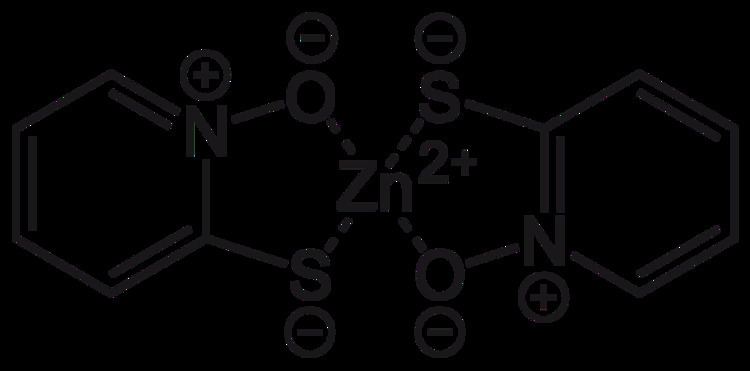Formula C10H8N2O2S2Zn CAS ID 13463-41-7 Soluble in Water | Melting point 240 °C Molar mass 317.7 g/mol Appearance colourless solid | |
 | ||
IUPAC ID bis(2-pyridylthio)zinc 1,1'-dioxide | ||
What does zinc pyrithione mean
Zinc pyrithione (or pyrithione zinc) is a coordination complex of zinc. It has fungistatic (that is, it inhibits the division of fungal cells) and bacteriostatic (inhibits bacterial cell division) properties and is used in the treatment of seborrhoeic dermatitis.
Contents
- What does zinc pyrithione mean
- Structure of the compound
- Medical
- In paint
- In sponges
- Mechanism of action
- Health effects
- Brands
- References
Structure of the compound
The pyrithione ligands, which are formally monoanions, are chelated to Zn2+ via oxygen and sulfur centers. In the crystalline state, zinc pyrithione exists as a centrosymmetric dimer (see figure), where each zinc is bonded to two sulfur and three oxygen centers. In solution, however, the dimers dissociate via scission of one Zn-O bond.
This compound was first described in the 1930s.
Pyrithione is the conjugate base derived from 2-mercaptopyridine-N-oxide (CAS# 1121-31-9), a derivative of pyridine-N-oxide.
Medical
Zinc pyrithione is best known for its use in treating dandruff and seborrhoeic dermatitis, particularly in dandruff shampoos. It also has antibacterial properties and is effective against many pathogens from the Streptococcus and Staphylococcus genera. Its other medical applications include treatments of psoriasis, eczema, ringworm, fungus, athletes foot, dry skin, atopic dermatitis, tinea, and vitiligo.
In paint
Due to its low solubility in water (8 ppm at neutral pH), zinc pyrithione is suitable for use in outdoor paints and other products that provide protection against mildew and algae. It is an effective algaecide. It is chemically incompatible with paints relying on metal carboxylate curing agents. When used in latex paints with water containing high amount of iron, a sequestering agent that will preferentially bind the iron ions is needed. Its decomposition by ultraviolet light is slow, providing years of protection even against direct sunlight.
In sponges
Zinc pyrithione is also used as an antibacterial treatment for household sponges, most notably by the 3M Corporation.
Mechanism of action
Its antifungal effect is thought to derive from its ability to disrupt membrane transport by blocking the proton pump that energizes the transport mechanism.
Health effects
Zinc pyrithione is approved for over-the-counter topical use in the United States as a treatment for dandruff and is the active ingredient in several antidandruff shampoos. However, in its industrial forms and strengths, it may be harmful by contact or ingestion. Zinc pyrithione can trigger a variety of responses.
Brands
Head & Shoulders is an American brand of anti-dandruff and non-dandruff shampoo produced by parent company Procter & Gamble that was introduced in 1961. The active ingredient is pyrithione zinc.
